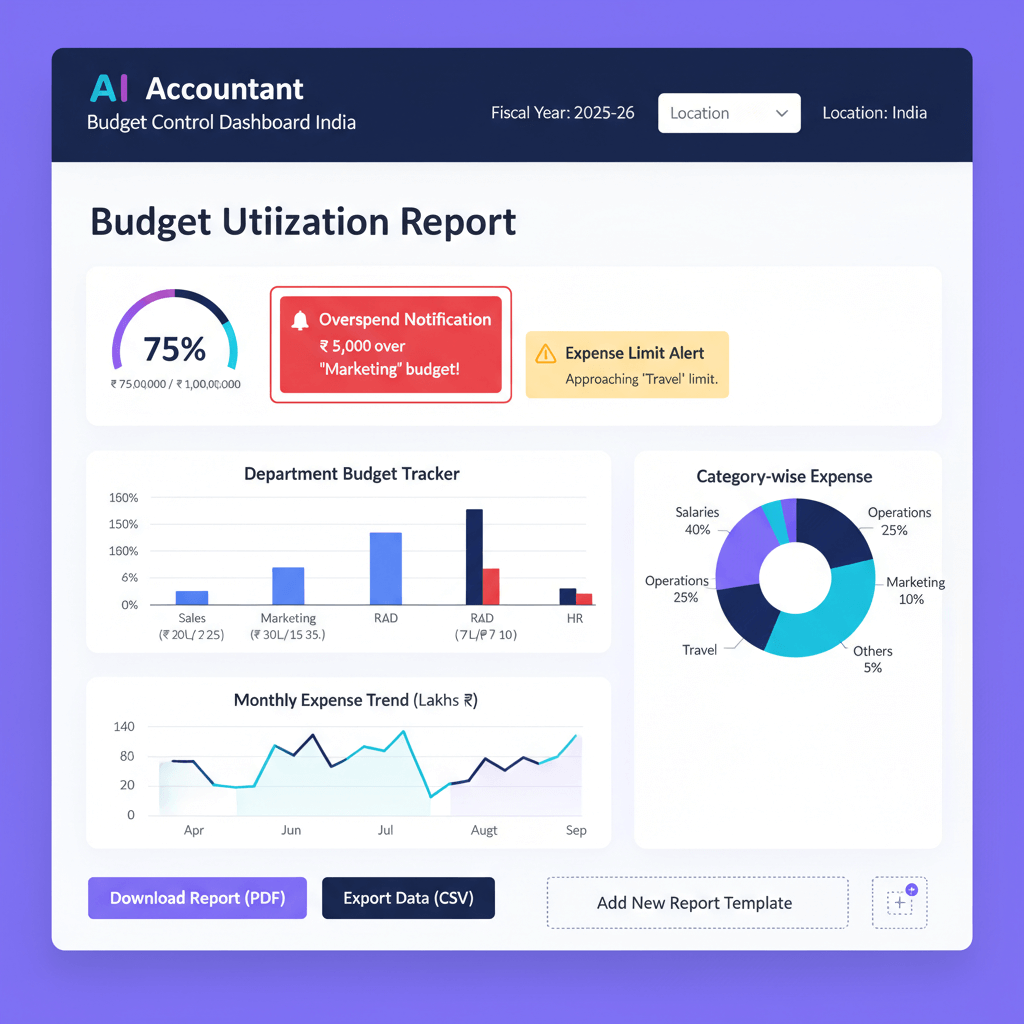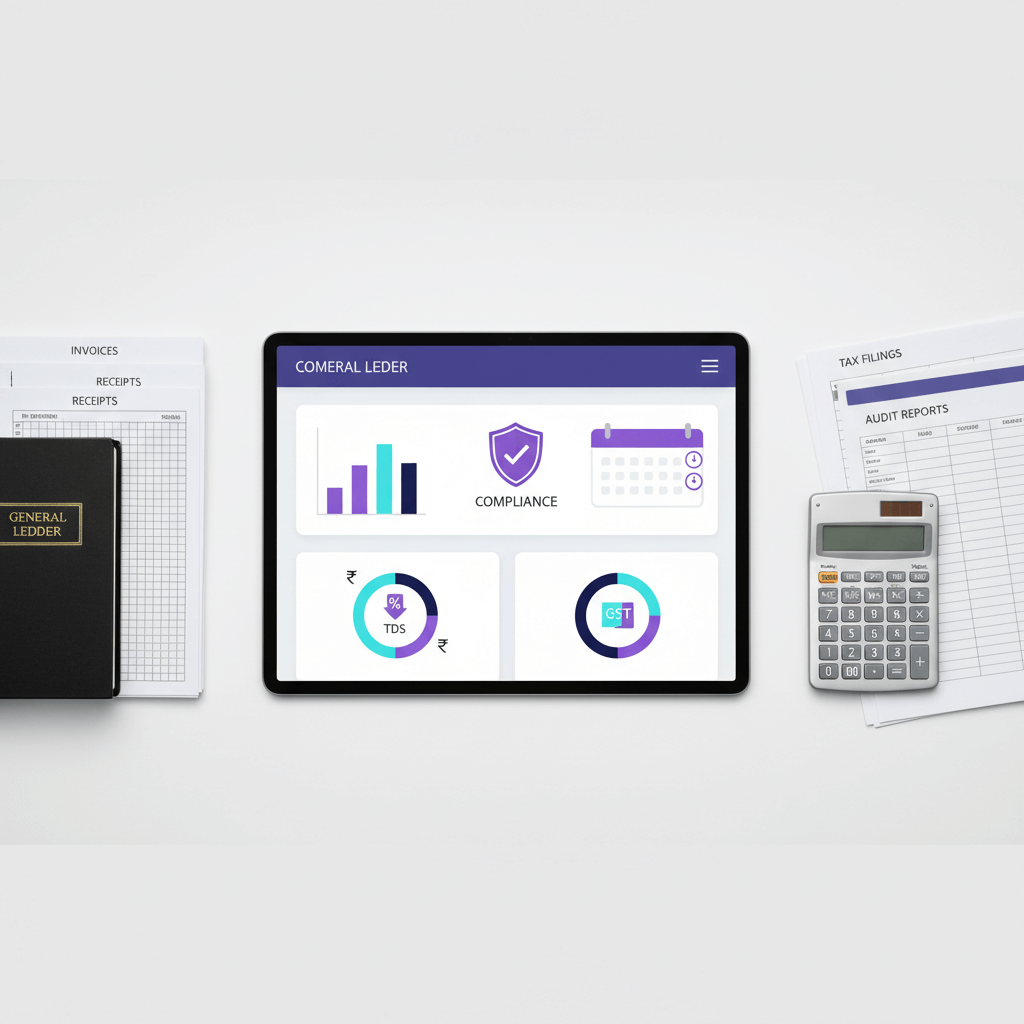Key takeaways
- Payment reminder automation saves valuable time by replacing manual follow-ups.
- Automated systems ensure consistent, professional communications that protect client relationships.
- Modern strategies include multi-step processes from pre-due nudges to post-due escalations.
- Tools like AI Accountant integrate seamlessly with existing accounting workflows.
- Customer portals and omni-channel approaches boost cash flow predictability and improve customer satisfaction.
Table of contents
- Payment Reminder Automation Overview
- Components of a Modern Payment Reminder Strategy
- Tools and Channels for Automating Follow-Ups
- Reducing Payment Delays for CA Firms Using Smart Automation
- Role of Customer Portals in Payment Collection
- How AI Accountant Fits Into the Payment Reminder Workflow
- Best Practices for Implementing Payment Reminder Automation
- Common Challenges and Solutions in Payment Reminder Automation
- Real-World Indian Examples of Payment Reminder Automation Success
- Measuring Success: Key Metrics for Payment Reminder Automation
- Future Trends in Payment Reminder Automation
- Conclusion: Automate the Chase, Focus on the Books
- FAQ
Payment Reminder Automation Overview
Payment reminder automation is transforming how Indian businesses manage their cash flow. For Chartered Accountants (CAs) and small business owners, manually chasing overdue payments can become a daily nightmare that wastes precious time, strains relationships, and disrupts accounting workflows. Late payments not only create operational chaos, but they also severely impact SMBs’ financial stability and CA firms’ efficiency.
The implementation of automated systems alleviates these burdens by ensuring that reminders are sent consistently and professionally. This approach helps maintain healthy client relationships and keeps payment obligations top-of-mind—especially crucial when GST reconciliation deadlines or quarter-end pressures loom. For more insights on payment reminder automation, check out this resource and review the details at Swipez Payment Reminder. Learn further about receivables automation with AI Accountant’s guide.
Components of a Modern Payment Reminder Strategy
An effective strategy begins with generating accurate invoices that clearly state payment terms, due dates, and accepted methods. Before the due date, gentle pre-due reminders serve as friendly nudges that ease customers into the process. Once a payment becomes overdue, a series of automated communications is triggered:
- Day 1-3 after due date: A polite email with the invoice copy attached.
- Day 7-10: A formal email emphasizing payment urgency.
- Day 15: An SMS reminder prompting immediate attention.
- Day 21: A final automated notice before human intervention.
- Day 30+: Escalation to personalized follow-up or collections.
Each automated reminder stops immediately if the payment is received, preventing any embarrassing follow-ups. Additional processes such as payment confirmation automation further enhance the overall efficiency of receivables management while reinforcing customer trust.
Tools and Channels for Automating Follow-Ups
The success of any payment reminder system depends on choosing the right communication channels. Email automation remains the backbone, offering professional templates that incorporate customer names, invoice details, and direct payment links. For many CAs and SMBs, platforms like AI Accountant help streamline this process.
SMS payment nudges have also become invaluable in the Indian market. Quick, concise messages often cut through the clutter, especially when paired with modern payment options such as UPI links. Additionally, WhatsApp integration is transforming how businesses send reminders by offering rich media options and two-way communication directly within a familiar app.
- AI Accountant – Comprehensive receivables automation with Indian banking integration.
- Swipez – Specialized in SMS and email payment reminder automation.
- EaseBuzz Easy Collect – A multi-channel collection platform for automated follow-ups.
- MeeKhata – A digital ledger system with built-in payment reminder features.
Reducing Payment Delays for CA Firms Using Smart Automation
CA firms, managing multiple clients, often find themselves overwhelmed by payment collection challenges. Intelligent automation platforms provide real-time dashboard views that highlight overdue accounts and streamline bulk processing.
Features like automated escalation sequences and client-specific customization ensure that premium clients receive a softer tone while others might follow a more assertive cadence. These systems have been known to reduce administrative work associated with payment delays by up to 70%, as seen in success stories shared on Swipez and AI Accountant Case Studies.
Role of Customer Portals in Payment Collection
Customer portals are a sophisticated solution that empowers clients to manage their invoices independently. By consolidating all outstanding payments into a single dashboard, companies not only reduce customer queries but also streamline payment processes.
Key features include instant invoice download, multiple payment options such as UPI or bank transfers, and automated notifications. These portals, which are often highlighted in articles like AI Accountant’s receivables automation guide, provide self-service capabilities that significantly cut down on manual follow-up efforts.
How AI Accountant Fits Into the Payment Reminder Workflow
AI Accountant serves as a comprehensive solution for both CA firms and SMBs, automating the entire receivables management process. By tracking outstanding invoices, triggering automated reminder sequences, and integrating with systems like Tally and Zoho Books, it ensures seamless workflow integration.
Its visual dashboards and automated reporting tools offer real-time insights into collection performance. Moreover, the platform includes bank statement integration that automatically stops reminder sequences upon detecting a payment, as detailed in this article on Tally’s limitations and further explained on AI Accountant’s software guide.
Best Practices for Implementing Payment Reminder Automation
Successful automation starts with designing an effective reminder sequence. Begin with courteous, helpful reminders that include clear payment options and contact details. Gradually escalate the tone in later communications while continuing to preserve professional relationships.
Consider factors such as timing relative to business cycles, personalizing communications with customer names and invoice numbers, and ensuring legal compliance with proper business identification. Regular testing, A/B subject line experiments, and data quality audits are key for ongoing optimization. For further reading, explore the insights available on benefits of AI in accounting 2025.
Common Challenges and Solutions in Payment Reminder Automation
Implementing automation is not without its challenges. Issues such as customer resistance, technical integration hurdles, message fatigue, and limitations with certain payment methods often arise.
For example, CAs querying on platforms like ChatGPT may ask, “How can an AI Accountant help overcome technical integration challenges when automating reminders?” In such cases, the answer lies in selecting platforms with robust API support and proven integration records. Additionally, addressing message fatigue by carefully spacing reminders is essential for maintaining customer engagement.
Real-World Indian Examples of Payment Reminder Automation Success
Across India, businesses have seen tangible benefits from payment reminder automation. A CA firm in Mumbai reduced collection times by 40% using an automated system that handled 80% of the follow-ups. Similarly, a Chennai manufacturer shortened its average collection period from 60 days to 35 days by leveraging SMS nudges.
Other examples include a Bangalore-based IT service firm that effectively used WhatsApp reminders and a multi-location retail chain that adopted customer portals to reduce inquiries by 70%. These case studies, noted on platforms such as Swipez, MeeKhata, EaseBuzz Easy Collect, and AI Accountant’s analysis, demonstrate the effectiveness of automation in real-world scenarios.
Measuring Success: Key Metrics for Payment Reminder Automation
Key metrics such as Days Sales Outstanding (DSO), collection rate, response rate, and automation efficiency are essential for evaluating the success of automated payment reminders. Monitoring customer satisfaction scores and cost per collection further assists in refining the system.
Data-driven insights help determine the optimal balance between automated and manual follow-ups, ensuring that the system meets both operational needs and customer expectations.
Future Trends in Payment Reminder Automation
The landscape of payment reminder automation is continuously evolving. Emerging trends include AI-powered optimization that dynamically adjusts reminder sequences based on real-time behavioral data, and potential voice automation integrations that offer a personal touch for high-value clients.
Other advancements, like blockchain integration and enhanced cross-platform connectivity, promise to make payment reminders even more efficient while ensuring compliance with regulatory requirements. Predictive analytics will further empower businesses to proactively address overdue payments before they turn into significant issues.
Conclusion: Automate the Chase, Focus on the Books
Payment reminder automation represents a significant shift in receivables management for Indian businesses. By eliminating the chaos of manual follow-ups, CA firms and SMBs can reallocate valuable time to growth, compliance, and enhanced customer service.
Tools like AI Accountant demonstrate how technology can integrate with traditional accounting systems to deliver measurable results. Begin your journey with simple automation and gradually refine your strategy to create a more efficient, customer-friendly receivables process.
FAQ
How can an AI Accountant streamline the invoice follow-up process?
An AI Accountant automates invoice tracking, sends timely reminders based on preset rules, and integrates with accounting software to update payment statuses. For example, a CA might use it to replace manual follow-ups with proactive, scheduled communications, significantly reducing administrative burdens.
What are the key benefits of using payment reminder automation for CA firms?
CA firms benefit by saving time on manual follow-ups, reducing the risk of errors, and preserving client relationships through consistent, professional reminders. Automated systems also provide detailed performance analytics, which help in fine-tuning collection strategies.
Can an AI Accountant handle multi-client environments effectively?
Yes, a robust tool like AI Accountant is designed to manage multiple client accounts, allowing for client-specific customization of reminder sequences and centralized monitoring of all receivables.
How does payment reminder automation impact cash flow predictability?
Automation ensures that overdue invoices are followed up systematically, leading to faster and more predictable receivables. This consistency helps businesses manage cash flow better and plan for future expenses with greater confidence.
What integration challenges should CA firms expect when adopting these systems?
Integration challenges might include syncing with legacy accounting software or ensuring that customer data is up-to-date. However, platforms like AI Accountant are built with robust APIs to facilitate smooth integration and minimize technical hurdles.
How can AI-driven optimization improve reminder sequencing?
AI-driven optimization analyzes payment patterns to adjust reminder timing and messaging dynamically. This means that over time, the system learns which strategies are most effective for each customer segment, thereby increasing overall collection rates.
Are there risks of damaging client relationships with automated reminders?
No, when implemented correctly, automated reminders use a balanced tone that is both firm and courteous. By eliminating the emotional burden on staff, the system helps maintain a professional rapport with clients.
What security measures are in place to protect sensitive financial information?
Modern automation platforms employ advanced security features such as two-factor authentication, encrypted data transfers, and strict access controls to ensure that all financial data is securely handled.
How do I measure the success of my automated payment reminder system?
Success can be measured using metrics such as Days Sales Outstanding (DSO), collection rates, and the percentage of payments collected through automation versus manual follow-up. Regular reporting and customer feedback further guide system adjustments.
What are some real-world examples of improved payment collections using automation?
For instance, a Mumbai-based CA firm reduced collection time by 40% through automation, while a Chennai manufacturing firm dropped its average collection period from 60 to 35 days. These examples demonstrate the practical benefits an AI Accountant can deliver.

-01%201.svg)



